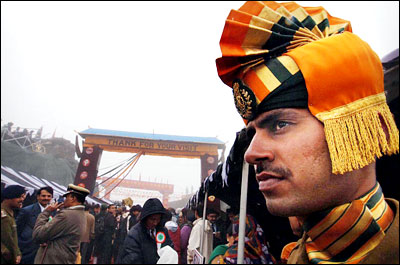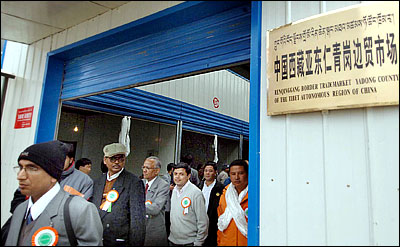| Tools: Save | Print | E-mail | Most Read |
| China-India Border Trade 'Not Ideal' |
| Adjust font size: |
China and India last month reopened cross border trade through the Himalayan Nathu La Pass but business was running at a "low level" and was "not ideal," a Chinese official said Thursday. "India has unilaterally imposed restrictions on trade through Nathu La," said Hao Peng, vice chairman of the Tibet Autonomous Region, when meeting with a visiting Indian media delegation in the regional capital of Lhasa. Hao said that India authorized the export of only 29 items to China and a mere 15 items were permitted to enter the Indian market from China. When China opened a trade mart at Renqinggang, 16 kilometers from the Nathu La Pass, India opened the Changgu market in neighboring Sikkim. However, while Indian business people could stay at the Renqinggang mart Chinese traders couldn't spend the night in India, Hao said. China and India reopened border trade through the Nathu La Pass on July 6, 44 years after a border conflict closed down the ancient "Silk Road". The Pass sits 4,545 meters above sea level and is wedged between Yadong County in Tibet's Xigaze Prefecture and India's Sikkim State. Previously more than 90 percent of trade between China and India was by sea and via Tianjin -- a port city some 120 kilometers from Beijing but nearly 4,400 kilometers from Lhasa. With the reopening of the Pass it's only 1,200 kilometers by land from Lhasa to Calcutta which is a major Indian coastal city. Analysts consider the reopening of the trade route to be an important development in Sino-Indian relations and expect the two sides to develop political trust as well as trade and economic relations.
The Pass would help shape a major land trade route linking China with South Asia and reduce transportation costs, according to Liu Jiangyong, an international studies specialist with Tsinghua University in Beijing. "Trade at the Renqinggang mart is currently less than 100,000 yuan (US$12,500) per week...much less than we had expected," Hao said. China didn't impose any restrictions on cross border trade except for illegal items and hostels had been built to accommodate Indian traders, he said. "I hope the Indian government will adopt a more egalitarian approach to cross border trade with China," added Hao. The Indian delegation leader, Ranjan Roy, editor of The Times of India, a major newspaper, said India might have some concerns about low-price Chinese products flooding the Indian market. He suggested the two governments communicate more with each other on this issue and work out common solutions. "I can sense China's enthusiasm to promote border trade with India," he said. "Given the remarkable potential the two sides should deepen their cooperation on the issue." Trade through the Pass accounted for 80 percent of total cross border trade between the two countries in the early 1900s. But after the border conflict in 1962 they closed their customs points at the former border markets and the trade route became a tightly guarded frontier post. In the final years of the 20th century Sino-Indian relations started to thaw and in 2003 the two countries agreed to reopen markets at the Nathu La Pass. And China approved plans to build a border market in Yadong last year. During Premier Wen Jiabao's visit to India last year the two countries vowed to establish a strategic partnership in the interests of peace and prosperity. China and India recorded US$18.73 billion of trade last year, up 37.5 percent year-on-year, according to the Chinese Ministry of Commerce. The figure is expected to exceed US$20 billion this year. The year 2006 has been designated the year of Sino-Indian friendship.
(Xinhua News Agency August 11, 2006) |
| Tools: Save | Print | E-mail | Most Read |
 |
| Related Stories |
| Product Directory China Search |
Country Search Hot Buys |

